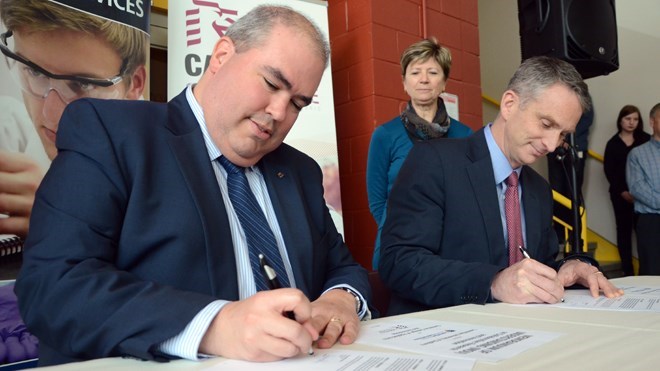Two halves of a whole, when combined, are stronger than they are apart.
That's the idea behind an agreement between Sudbury’s Cambrian College and Laurentian University, which was made official March 8.
“Any time Cambrian College and Laurentian University can work together is a good day,” said Cambrian president Bill Best, before signing a memorandum of understanding (MOU). “We've been looking at different ways to work together, and research is just another one of those elements.”
The aim is to harness the resources and expertise of the two institutions, in order to enhance the educational experience for student researchers, attract and develop top quality professionals, increase fundamental and applied research capacity and income, and strengthen Sudbury’s culture of innovation through postsecondary collaboration.
Proximity is a beautiful thing, Best said, and when researchers from both institutions are working under the same roof, sharing the same space and equipment, good things are bound to happen.
Don't let the signing of the MOU fool you, though, he said. Cambrian and Laurentian working together is nothing new.
“We've been working with Laurentian already, but now that we're making it official to the public, we can move on to the next level,” Best said.
Laurentian president Dominic Giroux said the agreement allows both the college and the university to collaborate more on large-scale research projects.
“Some federal program for research are earmarked for university, some for college, but working together will allow us to maximize the opportunities for Greater Sudbury,” he said.
Currently, Cambrian and Laurentian are investigating how a unique hydraulic air compressor (HAC) system may be developed to clean and cool the air in ultra-deep mining environments, where air temperatures may reach upwards of 40 degrees Celsius.
Laurentian researchers are teaming up with Cambrian faculty and students to conduct trials on what they've nicknamed “BabyHAC,” a pilot-scale unit installed at Cambrian’s Glencore Centre for Innovation.
In the meantime, construction of the much larger Dynamic Earth HAC is underway. Faculty and students in Cambrian’s metalworking shops are fabricating a key part of the Dynamic Earth HAC: A 21st-century version of an air-water mixing head last used in the Peterborough Lift Lock HAC in 1967 that was designed by graduate students working within Laurentian’s MIRARCO research facility.
Part of the agreement allows for adjunct appointments, too, he said, where Cambrian faculty will be considered for adjunct appointments at the university.




